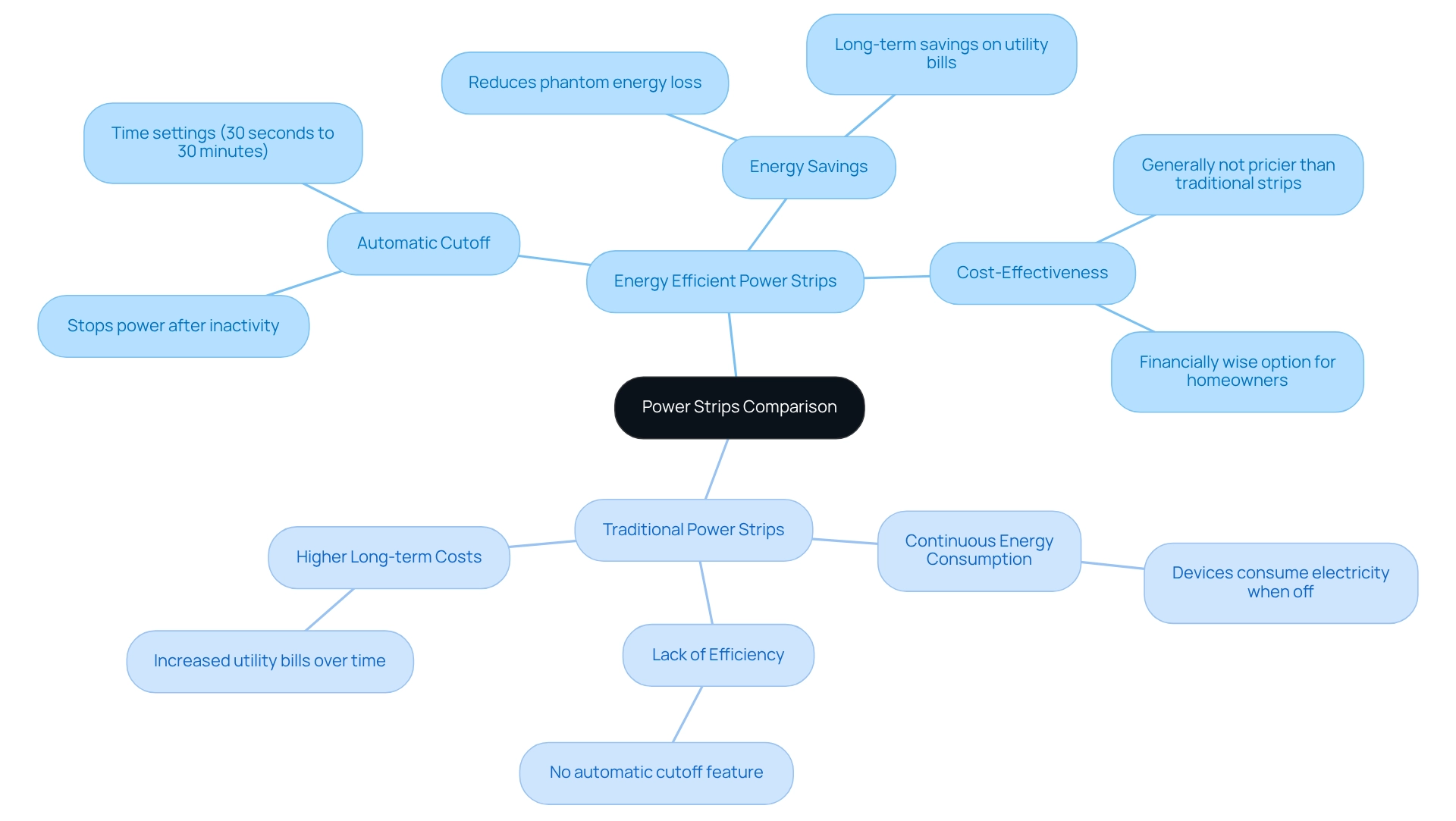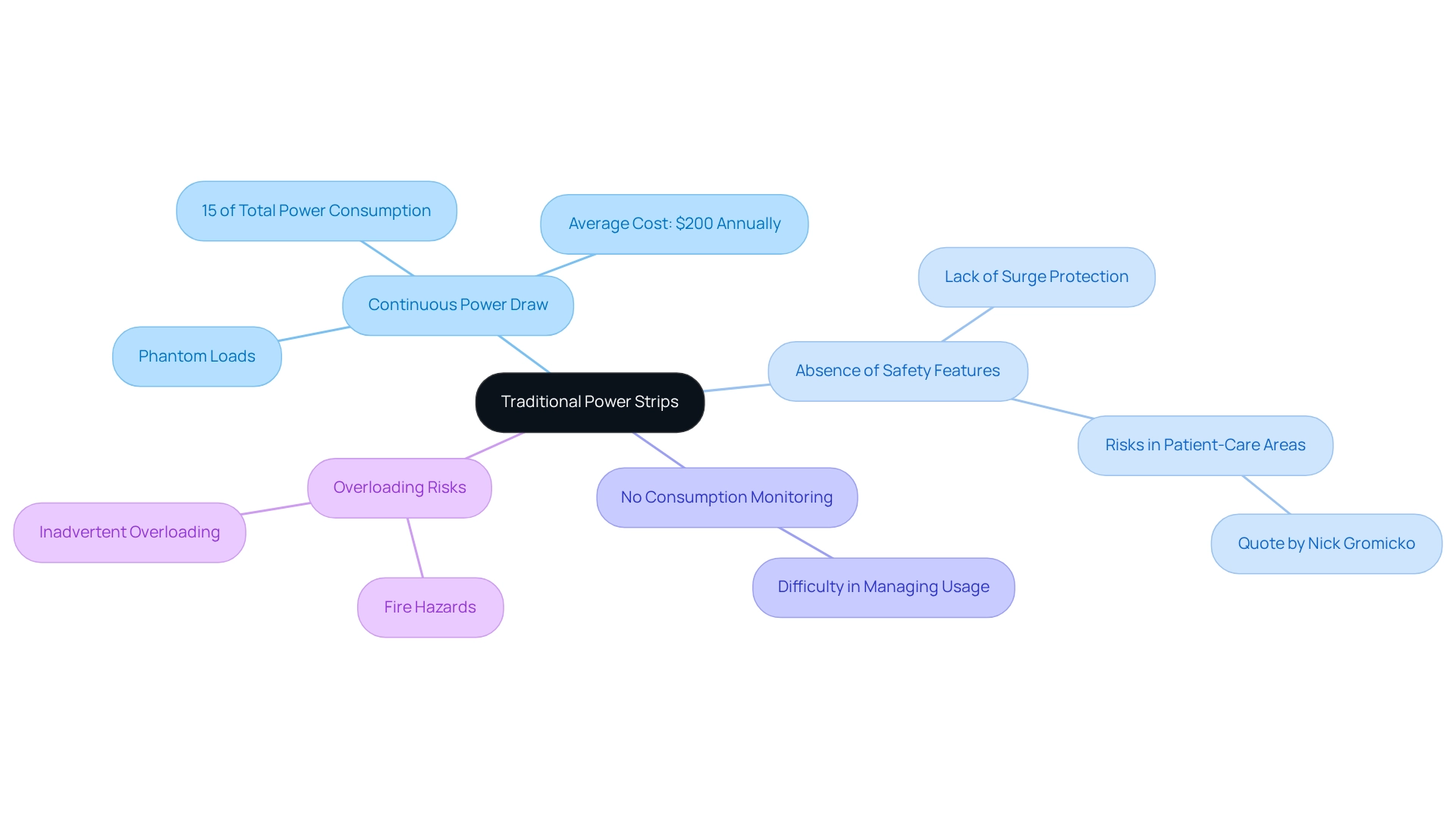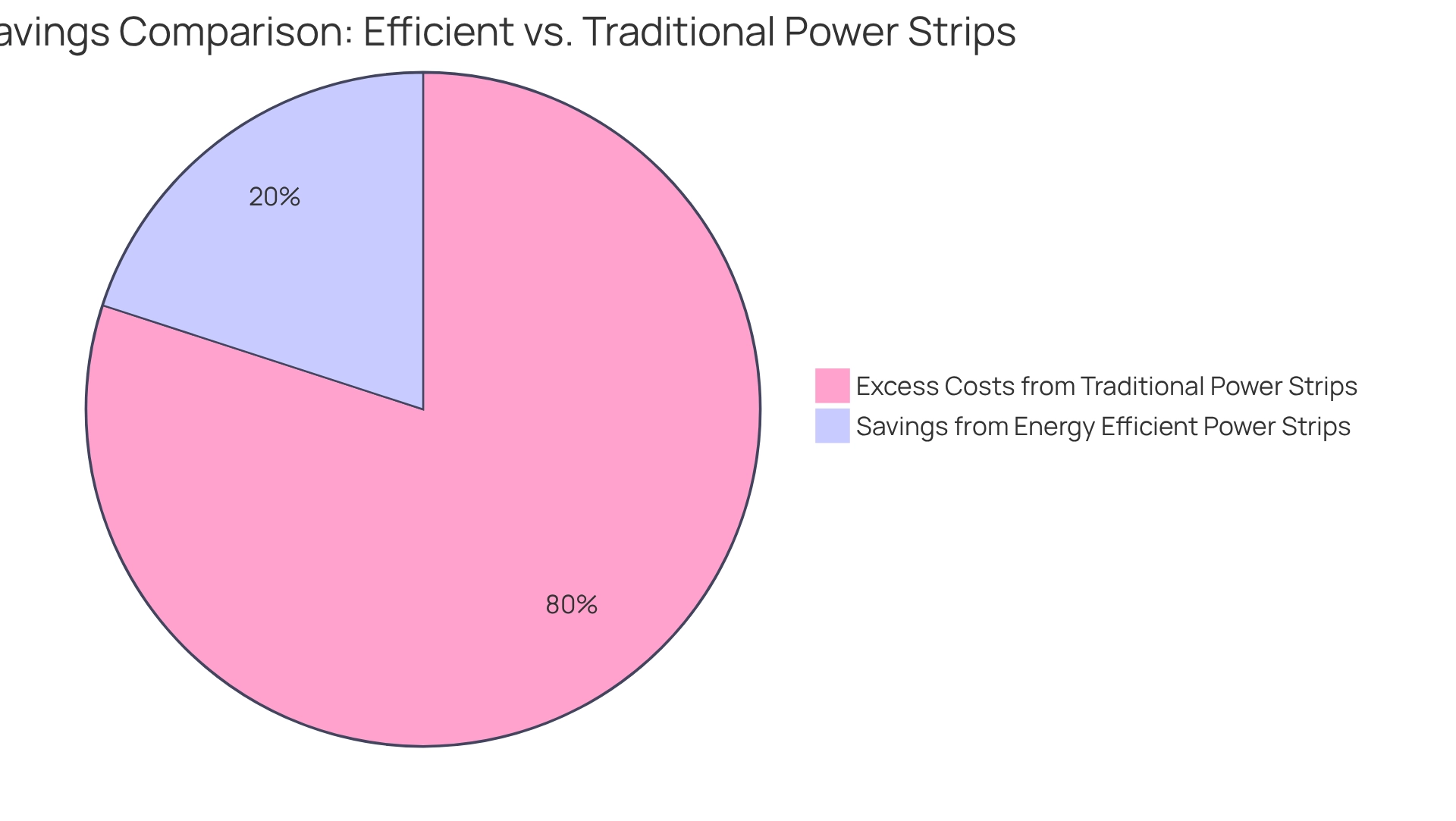Overview
We understand that rising energy bills can be a source of concern for many homeowners. The key comparisons between energy-efficient power strips and traditional power strips reveal a significant opportunity for reducing energy waste.
Energy-efficient models automatically cut power to idle devices, which can lead to potential savings on your electricity bills. It’s common to feel overwhelmed by the thought of phantom energy loads, which can account for up to 15% of household energy consumption. Traditional power strips often contribute to this issue, but energy-efficient strips come equipped with features like automatic shut-off and power monitoring that not only enhance usability but also prioritize safety.
Together, we can take steps towards energy independence and a more sustainable future. By choosing energy-efficient solutions, you’re not just saving money; you’re making a positive impact on the environment. Let’s work towards a brighter, more energy-conscious tomorrow.
Introduction
In a world that increasingly prioritizes sustainability, many homeowners find themselves concerned about rising energy bills and the impact of their choices on the environment. The decision between energy-efficient and traditional power strips can significantly influence both energy consumption and household expenses.
Energy-efficient power strips, often equipped with smart technology, actively reduce energy waste by disconnecting power from devices that are not in use, addressing the pervasive issue of phantom energy loss. On the other hand, traditional power strips simply expand outlet availability, allowing devices to draw power continuously—even when turned off.
Understanding these differences is crucial for homeowners who desire to enhance their energy efficiency, save on electricity bills, and contribute to a more sustainable future. As the demand for eco-friendly solutions grows, exploring the features, benefits, and drawbacks of each type of power strip reveals a compelling case for making the switch to energy-efficient models. Together, we can take meaningful steps towards energy independence and a more sustainable lifestyle.
Understanding Energy Efficient and Traditional Power Strips
We understand that many homeowners are concerned about rising energy bills and the impact of electricity consumption on their finances. Energy efficient power strips, often referred to as smart or advanced boards, are designed to greatly diminish waste by automatically cutting off supply from items that are not in active use. These boards are fitted with sensors that detect when an apparatus enters standby mode, effectively cutting off energy to prevent phantom energy loss. This functionality is especially significant considering that conventional surge protectors simply provide several outlets without any energy-efficient features, allowing devices to consume electricity continuously—even when they are switched off.
The implications of this operational difference are substantial. For example, the Isolé IDP-3050 model can disconnect electricity to six of its eight outlets after a room has been unoccupied for a predetermined duration, ranging from 30 seconds to 30 minutes. This functionality not only reduces unnecessary electricity usage but also leads to long-term savings on utility bills, making smart surge protectors a financially wise option for homeowners. Significantly, intelligent energy bars are usually not pricier than conventional energy connectors, which eases possible financial worries for buyers.
It’s common to feel overwhelmed by the conversations around resource conservation, yet the use of efficient power strips can result in a new economy centered on sustainability. Experts claim that energy efficient power strips play an essential role in reducing the burden of increasing utility costs and improving grid reliability. As one specialist observed, “We must have a relentless dedication to producing a significant, comprehensive resource package aimed at conservation, alleviating the burden of costs on consumers, decreasing our nation’s reliance on foreign oil, and enhancing electricity grid reliability.”
When used properly, intelligent energy management devices can produce substantial savings on electricity costs while lessening environmental impact. For instance, the case study named “Using Smart Power Strips Properly At Home” demonstrates how these tools can save resources by automatically turning off electricity to items that are not being utilized. However, it also highlights the difficulties in choosing the appropriate kind of smart energy management system based on the electronics configuration, as some gadgets may need continuous energy, complicating conservation efforts.
In summary, the primary distinctions between energy efficient power strips and conventional outlets lie in their functional abilities and potential for savings. Conventional extension cords permit devices to consume electricity continuously, while energy-saving versions actively eliminate this waste. As the market for resource-efficient solutions continues to expand, we encourage homeowners to explore these advanced alternatives to enhance their consumption and contribute to a more sustainable future. Together, we can make a difference in energy conservation and create a brighter tomorrow.
Key Features and Benefits of Energy Efficient Power Strips
Eco-friendly surge protectors, including energy efficient power strips, are designed with innovative features that not only enhance usability but also resonate with homeowners who are concerned about lowering their electricity usage. We understand that rising energy bills can be a source of stress, and these surge protectors offer meaningful solutions. Key features include:
- Automatic Shut-off: These strips can detect when devices are not in use, automatically cutting off power to minimize energy waste. This feature is especially advantageous, as studies suggest that equipment left connected can represent up to 10% of household energy consumption. Many energy efficient power strips come with surge protection, shielding delicate electronics from voltage spikes during storms or outages. Recent statistics show that intelligent energy-saving devices can safeguard equipment, providing reassurance against unforeseen electrical problems and prolonging the lifespan of connected devices.
- Power Monitoring: Sophisticated power bars often include power monitoring functions, offering live information on power usage. This empowers users to track their usage patterns and make informed decisions about their energy habits.
- Multiple Outlets: While maintaining the classic design of various outlets, these devices integrate energy-saving technologies that enhance efficiency.
The benefits of using an energy efficient power strip are significant. Homeowners can anticipate lower electricity bills and a reduced carbon footprint by utilizing an energy efficient power strip, contributing to a more sustainable lifestyle. These devices, when used with an energy efficient power strip, help reduce continuous energy consumption, extend the longevity of connected equipment, and ultimately lead to savings on replacements and repairs. As Johnny Bailey, founder of Planet Pristine, wisely states, “When I think about ethical sourcing for green products, it reminds me that it is not just a growing trend; it is an essential component of contemporary business practices.” This perspective reinforces the importance of integrating energy-efficient solutions into our homes. Moreover, by connecting energy-draining gadgets to an energy efficient power strip, homeowners can effectively decrease excessive energy usage. As the demand for energy-efficient solutions continues to grow, using an energy efficient power strip in our homes is becoming essential for eco-conscious consumers. Together, we can make a difference and foster a more sustainable future.
Characteristics and Drawbacks of Traditional Power Strips
Traditional power strips serve a basic function by expanding the number of available electrical outlets, but they come with significant drawbacks that an energy efficient power strip can help mitigate, improving both energy efficiency and safety. We understand that managing energy bills can be a concern for many homeowners, and it’s common to feel overwhelmed by the options available.
- Continuous Power Draw: Devices connected to traditional power strips often continue to draw power even when turned off, contributing to phantom loads. This phenomenon can represent up to 15% of a household’s total power consumption, costing the average home approximately $200 each year. A case study named ‘Reducing Phantom Energy Draws’ emphasizes how adopting solutions such as an energy efficient power strip, which allows homeowners to easily switch off several appliances, can greatly decrease phantom energy use, possibly saving them money and minimizing overall energy waste.
- Absence of Safety Features: Most conventional surge protectors lack integrated surge protection, leaving connected devices susceptible to electrical surges that can result in damage. As noted by safety expert Nick Gromicko, power extensions ‘have not been investigated and are not intended for use with general patient-care areas or critical patient-care areas of healthcare facilities,’ underscoring the risks associated with their use.
- No Consumption Monitoring: Conventional bands do not provide any feedback on usage, making it difficult for users to monitor and manage their consumption effectively.
- Overloading Risks: Users may inadvertently overload conventional devices, which can lead to fire hazards if not monitored properly. These constraints emphasize why conventional electrical outlets are less appropriate for eco-aware individuals seeking to reduce their consumption and improve safety in their residences, making the energy efficient power strip a better choice. Together, we can explore safer alternatives. Additionally, with most surge protectors priced under $50, investing in these solutions is both affordable and beneficial. Let’s work towards a more energy-efficient and safe home together.
Comparative Analysis: Energy Efficient vs. Traditional Power Strips
When considering the differences between traditional models and energy efficient power strips, it’s essential to address your concerns about energy bills and consumption. Energy-efficient power strips excel at minimizing energy waste by automatically cutting power to idle devices, which effectively reduces those pesky phantom loads that can inflate your electricity costs. In contrast, conventional strips allow for uninterrupted current usage, leading to excessive resource consumption that can weigh heavily on your wallet.
Imagine the relief of saving up to $100 annually on your electricity expenses by simply switching to an energy efficient power strip. Even if you never quite manage to turn off the TV before dozing off, intelligent power strips can still provide savings of around 20%. Traditional models, however, often contribute to increased expenses because they are ineffective in curbing phantom loads, whereas an energy efficient power strip can help mitigate these costs.
Safety is another critical aspect to consider. Many energy-efficient models come equipped with advanced safety features like surge protection and power monitoring capabilities. These enhancements significantly improve safety and usability compared to conventional extension cords, which typically lack such essential features.
User experience is paramount, and energy efficient power strips are designed with your comfort in mind. They offer features such as automatic shut-off and usage monitoring, which are often absent in traditional models. This makes energy-efficient alternatives not only a practical choice but also a more user-friendly option.
As Charlene Moody wisely points out, “by selecting the optimal intelligent extension cord for their circumstances, users can achieve a considerable reduction in their consumption—without needing to alter their electronics usage.” While traditional power strips meet the basic need for additional outlets, an energy efficient power strip offers a holistic solution that reduces energy consumption while enhancing safety and user experience.
Moreover, Powercore Electric’s strong community focus and commitment to transparency ensure that you receive personalized service and support. Together, we can navigate your solar and electrical needs in California, making Powercore Electric a trusted choice for those seeking meaningful and supportive interactions.
Conclusion
We understand that energy bills can be a significant concern for homeowners. The distinction between energy-efficient power strips and traditional models is not just clear; it’s crucial for your financial and environmental well-being. Energy-efficient power strips utilize smart technology to automatically disconnect power from devices that are not in use, effectively combating phantom energy loss. This leads to lower energy bills and fosters a more sustainable lifestyle by minimizing unnecessary energy consumption. In contrast, traditional power strips allow devices to draw power continuously, contributing to energy waste and potentially higher costs for you.
The features of energy-efficient power strips—such as automatic shut-off, surge protection, and energy monitoring—provide you with enhanced safety and convenience. These strips can yield substantial savings, both financially and environmentally, making them a wise investment for the eco-conscious consumer. Insights from case studies and expert opinions reinforce that switching to energy-efficient models is not merely a trend but a necessary step towards a more sustainable future.
As the demand for eco-friendly solutions grows, we encourage you to consider the advantages of energy-efficient power strips. By making an informed choice, you can significantly reduce your energy footprint, save on electricity costs, and contribute to a more sustainable world. Embracing these advanced technologies is a proactive approach to energy management that benefits both your household and the planet. Together, we can create a brighter, more sustainable future.






